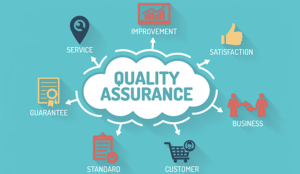On your marks, get set, go!
Natalie Calvert shares her experience with a discussion on how to define the term ‘customer experience’ for your business in the first place.
The best customer experiences are very simple:
From a customer’s point of view, interactions should be easy, enjoyable and make you happy to return and spend your money. They should delight you, even making you feel proud enough to tell your friends and colleagues.
From your organisation’s point of view, the best customer experiences mean more profitable and loyal advocates, and of course customers that rarely complain. Resultantly, you gain free PR and positive brand-building through word-of-mouth recommendations.
To an extent, the contact centre is the broker between the two – balancing organisational needs alongside customer needs. However, most contact centres have grown in an organic fashion, responding to high and ever increasing contact volumes and more demanding customers. In many ways, then, delivering the ultimate customer experience is much easier said than done. Most contact centres never have time to stop and think, after all.
It is now generally accepted that there is a very strong relationship between profitable organisations, highly engaged employees and great customer experiences. The Institute of Customer Service report, “The service profit chain”, demonstrates that those organisations that deliver service excellence deliver on average over 70 per cent greater profit per employee and 24 per cent higher average net margin. Additionally, satisfied customers are over five times more likely to stay with you longer and spend more. So providing good customer experiences is fundamental to long-term organisational success.
With this in mind, I want to share with you a very practical approach to understanding how to define the best customer experience for your organisation.
Stage 1: Planning by numbers
First of all, let us get our commercial context sorted out.
When it comes to defining where you want to be, my very first recommendation is to start with understanding what success looks like from a commercial point of view. This means clearly identifying your critical success factors (CSFs). This always gives context and puts some strong markers in the ground. It will also be valuable for calculating the impact further down the line.
The CSFs should include a 36-month outlook on some key indicators as I’ve laid out in the table below next to my estimates for what will be happening in the market. Hopefully this will give you a solid starting point:
| Critical success factors | Calcom’s view for next 36 months (2007-2010) |
| Revenue targets | Increase by 20 per cent + |
| Cost base | Reduce by 20 to 50 per cent |
| Customer base | Expand and increase contact volumes |
| Contact centre volumes | Significantly increased number of contacts per customer |
| Self service (interactive voice response / automation) | Strong drive to automation to take 50 per cent of contacts (transactional interactions) |
| Headcount | Reduce by 30 per cent |
The CSF commercial challenges are further compounded by the need to increase customer and employee experience.
Stage 2: Brand
You will need to examine your organisation’s brand values (if you haven’t done this already) and define what this means in the contact centre across all customer and employee touchpoints and engagement.
The key is to assess the following:
- What is the tonality of your centre today? Is it friendly, welcoming and caring, or is it professional, fast and dynamic? Perhaps it’s traditional, tired and flat? Critically, what do you want it to feel like?
- What about your competitors? What do they feel like? What’s their tonality? How can you differentiate yourselves? Examples are great here. Look at screenshots of websites, listen in to calls, understand the written message in their literature and so on.
In addition to this, you really need to understand your calls – and by that I mean the content, the actions, the tonality, the process and how the systems support the customer interaction. Listen to your interactive voice response (IVR) system. Even call directory enquiries and see what they say. You need to understand how contactable (and therefore accessible) you are.
There are five points you need to measure against here:
- The human factor
- Ease and access
- Tone and pace
- Delivery of solution
- The emotional connection
In simple terms, you are seeking to ‘wrap’ your organisation’s brand in to the DNA of your customer contact so that your customers’ experience will make the difference between contacting you and your competitors.
Stage 3: DreamOut
Next, step outside the box. Where exactly do you want to be?
The best way is to take all your key stakeholders – including marketing, sales, operations and the frontline – off for a DreamOut session: a workshop that enables teams to share ideas, tackle key issues and innovate while creating a new way of working.
To kick this off, I suggest sharing some industry benchmarking data, your customers’ feedback, employee feedback and of course your CSFs. Be warned that the preparation for this day might take several days or weeks to ensure you maximise time and output.
Now let the debate begin. During the DreamOut, you’ll need to brainstorm, debate and argue about what you believe the best customer experience look, feel and touch should be. To consolidate this, it can be worthwhile to develop a DESTINATION statement – a paragraph or two which articulates this.

There are three levels that you’ll need to consider in developing your ultimate customer experience, each building on the other from ‘Brilliant Basics’ to ‘Delivering an Extra Mile’ through to a ‘Value Add’ proposition that you might provide to key customer groups (see diagram below).
It all starts with Brilliant Basics – and without these in place, don’t even attempt to do more. You will just switch off your customers and frustrate your staff.
You’ll need to have a perspective that drives this process by customer segment as it is likely that you’ll look to differentiate your offering by customer type, value and future propensity.
Finally, during your DreamOut, explore each of these levels, clearly define what each level means for your organisation and its service offering. At this stage you will need to stay with the vision, the big picture. Don’t get trapped in the operational nuts and bolts. There will be plenty of time for that after all of this.
Stage 4: Moments of truth
Following the DreamOut you will also need to map out the customer journey in detail and define what that experience should be at each stage. This should not simply be from your own organisation’s point of view, but also from your customer’s point of view. A great way to look at this is to discover the ‘moments of truth’ and clearly define what you want that moment to translate in to and how you want your customer to behave and feel.
Some good examples of ‘moments of truth’ can be found in both the acquisition and retention stages of a customer interaction. In acquisitions, investigate how quotes, brochure requests, product queries and initial purchases are handled. In retaining customers, investigate how changes of details, complaints and bill payments are handled.

What next?
Once you have completed these four stages, the next step is to translate them in to budgets and operational plans for delivery through your contact centre channel.
A phased approach with rigorous testing built in to the plan is undoubtedly the best way forward so that you can measure the impact of all your changes in terms of bottom line, employee and, of course, your customer experience.
Natalie Calvert is managing director at the consultancy Calcom Group
The following comments have been posted relating to this article:
Thanks you for taking the time to write this article! I found it comforting to realise that the very issues we’re facing in our call centre are not unique! The bank I work for is struggling coming to grips with how best to operate and manage it’s contact centre. We do have hideously complex workflow metrics and formulas and the focus is still a ways removed from aligning operations to customer satisfaction and employee empowerment. Am enjoying this journey of discovery – again thanks for sharing – all good info and tips.
Author: Natalie Calvert
Reviewed by: Jonty Pearce
Published On: 21st Mar 2007 - Last modified: 15th Aug 2025
Read more about - Customer Service Strategy, Customer Experience (CX), Natalie Calvert, Service Strategy






















Hi i am doing a degree in secuirty management & i find this site helpfull the module i have to complwte is
WHAT ARE YOUR CUSTOMERS?.WHAT ARE THEIR DEFINING CHARACTERISTICS?AND WHAT STRATEGIES AND MECHANISMS CAN YOU USE TO BETTER UNDERSTAND YOUR CUSTOMERS AND THE MARKET IN WHICH YOU OPERATE?
Bit long but any information would be appreciated
p turner
assistant premises manager
university of wales newport